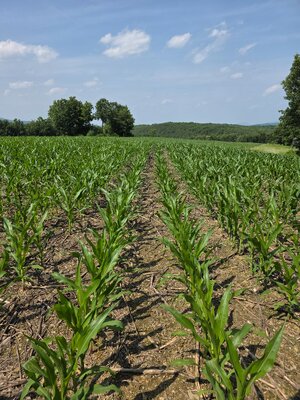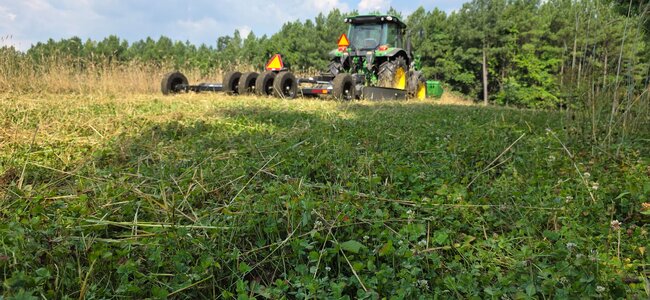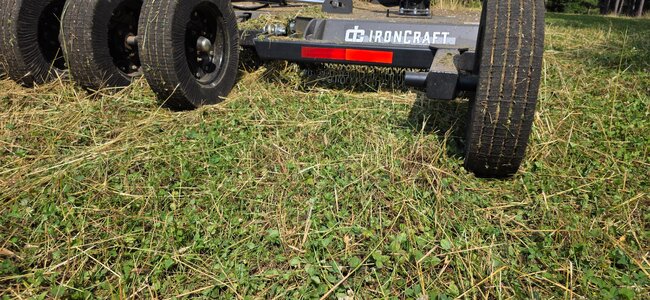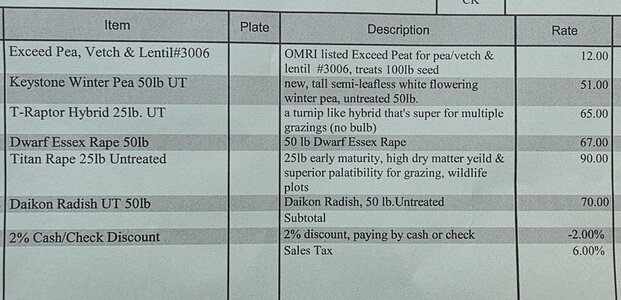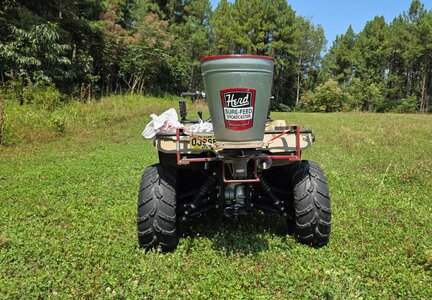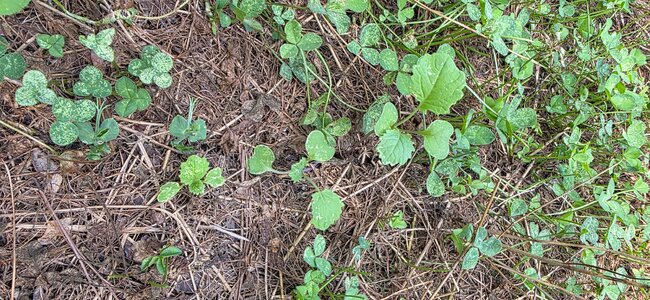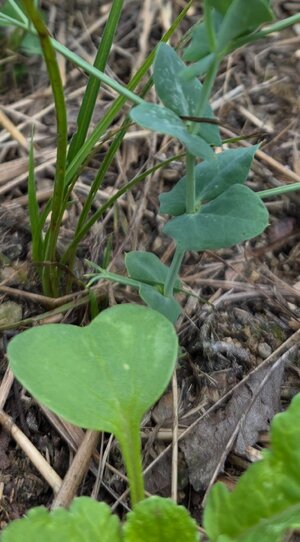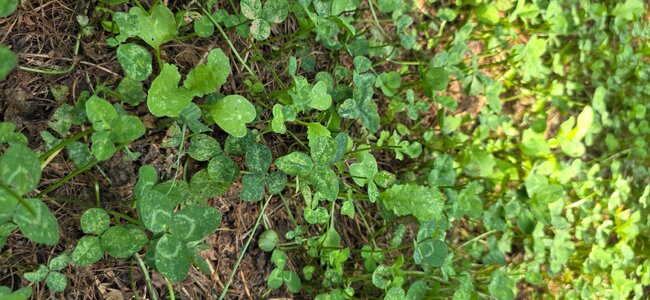-
The forum has been upgraded to support both light and dark themes. Click here for directions.
You are using an out of date browser. It may not display this or other websites correctly.
You should upgrade or use an alternative browser.
You should upgrade or use an alternative browser.
Keystone Krops
- Thread starter Mennoniteman
- Start date
Mennoniteman
Well-Known Member
But in food plots, size doesn't matter, it's all about quality. And you have way better quality food up in that saddle than I do in my cornfield. My problem is that I grew up on a farm and I have growing corn in my blood. You can take a boy out of the Amish but you can't take the Amish out of the boy type of thingPretty, that's a big food plot.
G
Mennoniteman
Well-Known Member
Recently my friend gave me a tour of his hunting farm. Our PA food plots are firing on all cylinders so far this summer, and good management practices like using the correct herbicides and fertilizer brings big results.
Here in this pic of one area of his operation you can see bare dirt in the foreground, ready for fall brassicas. Behind that is a strip of switchgrass for beddingcover, with a strip of oats behind that backing up to the hunting blind. On the left is freshly mowed ladino clover, and to the right out of the picture is several acres of corn. This will be a prime spot on the first day of hunting season.
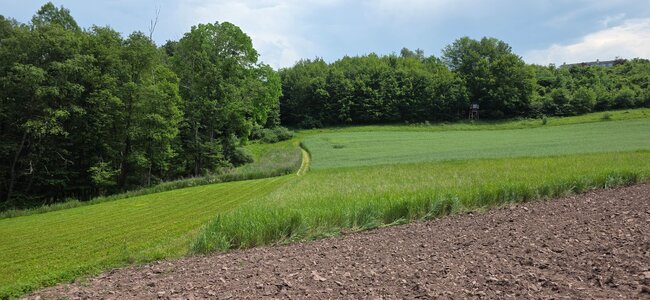
Here in this pic of one area of his operation you can see bare dirt in the foreground, ready for fall brassicas. Behind that is a strip of switchgrass for beddingcover, with a strip of oats behind that backing up to the hunting blind. On the left is freshly mowed ladino clover, and to the right out of the picture is several acres of corn. This will be a prime spot on the first day of hunting season.

Mennoniteman
Well-Known Member
It's a 10 acre field, 165 yards x 300 yards, they put deadly dozen in front of the blind for archery draw, however, most of their archery hunting is sitting along funnels in the woods.Amazing. What’s the distance to blind?
For rifle hunting there's no shot going to be more than 165 yards from that blind.
What struck me as the interesting thing about this 10 acre field layout is the switchgrass in the center. By the first of December when PA rifle opens bucks will be feeling hunting pressure in the woods and bed in the switch where they won't ever be disturbed and feel safe there, allowing them to control their deer herd with finesse, selectively shooting a few does in the woods while preserving the antlered deer in the switch except for the shooters.
I think this property has somewhere around 15 acres in switchgrass in 4 different plots on a farm that is only 100 acres, potentially allowing them to draw antled deer from their neighbors, This much switchgrass is something that is very unusual in PA.
The Midwest people often discuss switchgrass for bedding cover, but In the mid-atlantic region if we let sunshine hit the ground anywhere an instant jungle grows up for thick bedding cover, so planting something strictly for bedding cover isn't usually in our MO, and I wonder if we may be overlooking a powerful management tool.
Mennoniteman
Well-Known Member
Last September 1st we planted a ladino clover and cereal rye combo, now on July 11th I'm mowing the rye to release the clover. The rye ate up the excess nitrogen and converted it into carbon food for the Ladino in the form of straw that will break down and feed the clover. This clover is looking great, there's a thick layer of clover under the rye, although I probably will spray it with clethodim and Butyrac200 in several days to clean up the random weeds in the mix, then I'll interseed radishes and a small grain in mid-August and mow it after seeding to give the seeds some sunlight to germinate. 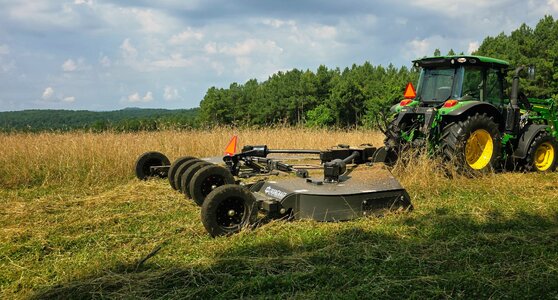

Attachments
Last edited:
birdog
New Member
The great thing about rye is what it does below ground. Rye has deep roots that bring nutrients up through its roots to where our shallow root food plot plants are. When rye is terminated the root system decays and feeds the clover and whatever else we plant.
I plant rye every fall into all of my plots.
I plant rye every fall into all of my plots.
birdog
New Member
Here in Illinois for the last 20 or so years the saying is head high by the 4th of July.The oldtimer farmers saying about corn is that you want it to be "knee high by 4th of July". With all the rain we've had it might be shoulder high by then. It's up to my hips on June 12.
View attachment 29829
Mennoniteman
Well-Known Member
When growing food plots the deck is usually stacked against you, but sometimes you do get a bit of good fortune going your way.
I don't like spraying food plots around the end of July because usually it's too hot and dry, and a lot of plants are in a partially dormant stage and not actively growing, leading to poor herbicide performance.
But I wanted to do a round of clethodim before I start planting fall plots in August, and get after some cattails before they reseed, so I decided to be bull headed and do what you're not supposed to.
This summer has been wetter than average, although it was getting dry when I sprayed on Friday morning right after daylight to take advantage of the morning dew and cooler temps, but the stroke of luck was when it rained a fair bit the next day, and now I have high hopes for this poorly timed effort.
The only thing that beats a nice stand of clover is soybeans, and with no soybeans in the neighborhood, this 4 acre ladino field is the best food in town, and averages 15 deer in it every morning and evening.
I don't like spraying food plots around the end of July because usually it's too hot and dry, and a lot of plants are in a partially dormant stage and not actively growing, leading to poor herbicide performance.
But I wanted to do a round of clethodim before I start planting fall plots in August, and get after some cattails before they reseed, so I decided to be bull headed and do what you're not supposed to.
This summer has been wetter than average, although it was getting dry when I sprayed on Friday morning right after daylight to take advantage of the morning dew and cooler temps, but the stroke of luck was when it rained a fair bit the next day, and now I have high hopes for this poorly timed effort.
The only thing that beats a nice stand of clover is soybeans, and with no soybeans in the neighborhood, this 4 acre ladino field is the best food in town, and averages 15 deer in it every morning and evening.
Last edited:
Mennoniteman
Well-Known Member
George
Well-Known Member
When growing food plots the deck is usually stacked against you, but sometimes you do get a bit of good fortune going your way.
I don't like spraying food plots around the end of July because usually it's too hot and dry, and a lot of plants are in a partially dormant stage and not actively growing, leading to poor herbicide performance.
But I wanted to do a round of clethodim before I start planting fall plots in August, and get after some cattails before they reseed, so I decided to be bull headed and do what you're not supposed to.
This summer has been wetter than average, although it was getting dry when I sprayed on Friday morning right after daylight to take advantage of the morning dew and cooler temps, but the stroke of luck was when it rained a fair bit the next day, and now I have high hopes for this poorly timed effort.
The only thing that beats a nice stand of clover is soybeans, and with no soybeans in the neighborhood, this 4 acre ladino field is the best food in town, and averages 15 deer in it every morning and evening.
Are you going to be famous on youtube like Okie and we'll never see you again?
G
Mennoniteman
Well-Known Member
Actors, influencers, and vocalists spend one year trying to be famous, then spend the rest of their lives hiding from people. Plus, if you didn't notice, most of those youtubers die at a young age from self medicating.Are you going to be famous on youtube like Okie and we'll never see you again?
G
I usually do all my plots no-till, but there comes a time when you just want to rip things up a bit and start over. Here I did 32 ozs of gly and 32 ozs of gluphosinate for a total burn down, now I'm disking, then I reseeded right after with radishes, 3 kinds of rape, plus crimson and ladino clover. I will add 200 lb rye on labor day.When growing food plots the deck is usually stacked against you, but sometimes you do get a bit of good fortune going your way.
I don't like spraying food plots around the end of July because usually it's too hot and dry, and a lot of plants are in a partially dormant stage and not actively growing, leading to poor herbicide performance.
But I wanted to do a round of clethodim before I start planting fall plots in August, and get after some cattails before they reseed, so I decided to be bull headed and do what you're not supposed to.
This summer has been wetter than average, although it was getting dry when I sprayed on Friday morning right after daylight to take advantage of the morning dew and cooler temps, but the stroke of luck was when it rained a fair bit the next day, and now I have high hopes for this poorly timed effort.
The only thing that beats a nice stand of clover is soybeans, and with no soybeans in the neighborhood, this 4 acre ladino field is the best food in town, and averages 15 deer in it every morning and evening.


Mennoniteman
Well-Known Member
Mennoniteman
Well-Known Member
dogghr
Well-Known Member
When growing food plots the deck is usually stacked against you, but sometimes you do get a bit of good fortune going your way.
I don't like spraying food plots around the end of July because usually it's too hot and dry, and a lot of plants are in a partially dormant stage and not actively growing, leading to poor herbicide performance.
But I wanted to do a round of clethodim before I start planting fall plots in August, and get after some cattails before they reseed, so I decided to be bull headed and do what you're not supposed to.
This summer has been wetter than average, although it was getting dry when I sprayed on Friday morning right after daylight to take advantage of the morning dew and cooler temps, but the stroke of luck was when it rained a fair bit the next day, and now I have high hopes for this poorly timed effort.
The only thing that beats a nice stand of clover is soybeans, and with no soybeans in the neighborhood, this 4 acre ladino field is the best food in town, and averages 15 deer in it every morning and evening.
Didn’t include AMS w this mix?
Sent from my iPhone using Tapatalk
Mennoniteman
Well-Known Member
Yes, I put AMS (in the form of Turbo) and crop oil into the tank first, then I mixed Butyrac 200 (1 quart per acre) and Clethodim (1 pint per acre) to the mix. Like I said, I got lucky with some rain afterwards and my clover fields are really cleaned up. The proof is in several skippers that I made, slivers of very ugly looking cattails and weeds there, almost like an exclusion cage effect.Didn’t include AMS w this mix?
Sent from my iPhone using Tapatalk
Some sources say you can't tank mix Butyrac and Clethodim, and other places say you can, but I had no trouble with mixing these two.
I have used Imazethapyr in the past since it's very powerful and kills everything except clover, but Imazethapyr has a fairly long residual effect. With the Butyrac and Clethodim mix I cleaned up about everything except clover without any carry-over residual effect, so I could interseed peas, radishes, and triticale right away, and also both of these products are relatively cheap.
Read post #15 in this thread about the "Turbo" AMS additive:
A real coincidence, after discussing AMS with you yesterday I went to Daniel's Farm Store to buy some and the guy said, hey, would you be interested in an alternative, only slightly more expensive with some added benefits? So I bought 2 cases of Turbo for $17.75 per gallon, 1 gallon treats 200 gallons of water, which comes to $8.88 per hundred gallons of water at 1 quart coverage.I just did some reading on this, after an ineffective burn down. Make sure you add the AMS before you add the herbicide!
I'm sure open about replacing dry AMS, it's difficult to work with and...
dogghr
Well-Known Member
Yes, I put AMS (in the form of Turbo) and crop oil into the tank first, then I mixed Butyrac 200 (1 quart per acre) and Clethodim (1 pint per acre) to the mix. Like I said, I got lucky with some rain afterwards and my clover fields are really cleaned up. The proof is in several skippers that I made, slivers of very ugly looking cattails and weeds there, almost like an exclusion cage effect.
Some sources say you can't tank mix Butyrac and Clethodim, and other places say you can, but I had no trouble with mixing these two.
I have used Imazethapyr in the past since it's very powerful and kills everything except clover, but Imazethapyr has a fairly long residual effect. With the Butyrac and Clethodim mix I cleaned up about everything except clover without any carry-over residual effect, so I could interseed peas, radishes, and triticale right away, and also both of these products are relatively cheap.
Read post #15 in this thread about the "Turbo" AMS additive:
A real coincidence, after discussing AMS with you yesterday I went to Daniel's Farm Store to buy some and the guy said, hey, would you be interested in an alternative, only slightly more expensive with some added benefits? So I bought 2 cases of Turbo for $17.75 per gallon, 1 gallon treats 200 gallons of water, which comes to $8.88 per hundred gallons of water at 1 quart coverage.I just did some reading on this, after an ineffective burn down. Make sure you add the AMS before you add the herbicide!
I'm sure open about replacing dry AMS, it's difficult to work with and...
Cool. I also mix the Cleth and Butyrac w great results. And like you Imazethapur cleans up good but gives problems w residual effect so I don’t use it much since I overseed plots w WR and/or brassica mix each fall. Thanks for your details
Sent from my iPhone using Tapatalk
Mennoniteman
Well-Known Member
A lot of foodplotters (in cooler climates) don't understand and take advantage of the opportunity of seeding their fall plots (brassicas and grain) into year round clover fields, and eliminating weeds before doing this is very key to this process, even if it burns the clover a bit, spray damage to the clover leaves is collateral damage that I'm willing to take to attain my longer term goals, a bit of leaf burning is only short term, and having the clover a bit stunted while the inter-seeded crop is establishing is actually a good thing.I was told by Keystone tech support that mixing 2,4-db and cleth together can make the mix too "hot" and possibly burn your clover. They recommended mixing at the lowest recommended rates for both to avoid clover damage.
You can see by this picture that my clover is a bit burnt and yet the peas and radishes I inter-seeded soon after spraying are growing well, so my goals of cleaning up weeds and prepping for the brassica inter-seeding and the upcoming rye inter-seeding have been met, and the clover should snap right back as soon as it starts growing again.
There's a fine line between making the mix too hot and not killing your grasses, and a lot of this is linked to how much rain you get in the week after spraying. Rain helps the clover jump right back if it's burned a bit, drought exacerbates the burnt condition. Half of the success of targeted spraying of weeds in clover involves having the clover put in a growth spurt and choking out the dying weeds soon after spraying, which is why it's a bad idea to spray in mid-summer when the clover is dormant.
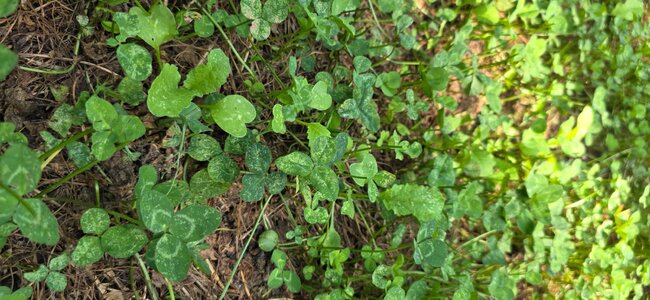
Similar threads
- Replies
- 10
- Views
- 4K

